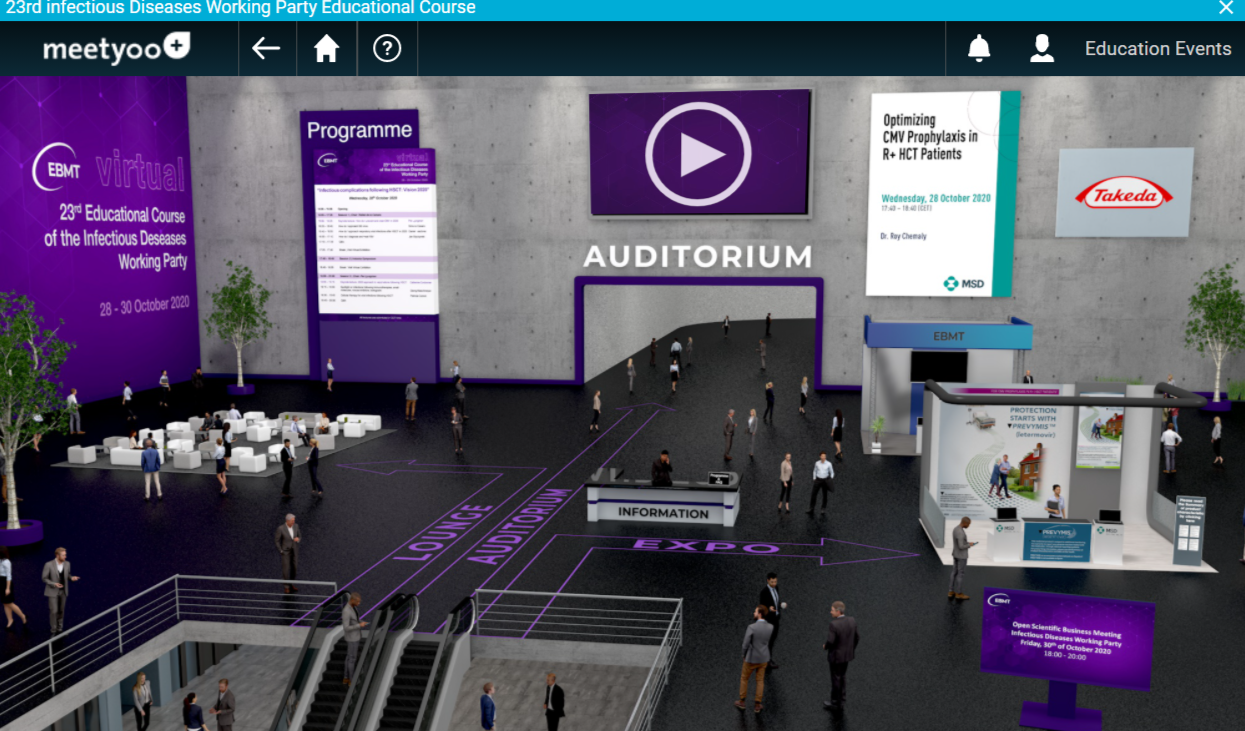
28-30 October 2020, Virtual
Wednesday, 28 October 2020
Sessions 1, 2 and 3
Summary by Rafael de la Camara, IDWP Chair, Hospital de la Princesa, Madrid, Spain
Session 1, chaired by Rafael de la Cámara (Madrid, Spain), was dedicated to CMV, EBV, BK and respiratory viruses. Dr Per Ljungman (Stockholm, Sweden) updated in a Keynote lecture “How do I prevent and treat CMV in 2020”. All centres doing allogeneic SCT needs to have a CMV management strategy. Treatment of CMV disease has to been seen as a failure of that strategy. But for CMV complication prevention, which strategy is the best in 2020 (prophylactic or preemptive therapy)? The latest evidence about preventive strategies was reviewed, including the new antiviral letermovir, and the latest ECIL guidelines.
Dr Simone Cesaro (Verona, Italy) presented a review of the today situation of BK infection in SCT. In SCT, BK is associated mainly with hemorrhagic cystitis. The pathogenesis, diagnosis criteria, predictive values of viruria and viremia, and treatment for this complication was reviewed, together with the 2018 ECIL guidelines. Antivirals have a limited role in therapy. Other possibilities of treatment were examined (fibrin glue, mesenchymal cells, specific T cell therapy, and others).
Dr Daniel Teschner (Mainz, Germany) discussed the approach to respiratory viral infections after HSCT, reviewing working definitions, diagnostics considerations, viral epidemiology, and specific recommendations for different respiratory viral infections.
Finally, Dr Jan Styczynski, the previous chair of the IDWP, presented “ How do I diagnose and treat EBV”. The main complication of EBV in SCT is post-transplant lymphoproliferative disorder (PTLD). Its pathogenesis, clinical presentations, diagnosis, preventive strategies, and therapy were reviewed.
Session 2, MSD Industry Symposium. Dr Roy Chemaly (Houston, USA) presented an updated of CMV prophylaxis in CMV seropositive patients, reviewing the experience of the MD Anderson Cancer Center with letermovir. The immune cellular response to CMV is another player that has to be considered together with the other more classical virologic parameters like viral replication.
Session 3, chaired by Per Ljungman (Stockholm, Sweden) started with a Keynote lecture by Dr Catherine Cordonnier: “2020 approach to vaccinations following HSCT”. An updated on this important issue for all SCT patients was presented, highlighting the most important points of the vaccination program that all patients should follow. A summary of the latest ECIL guidelines was presented. Emphasis was put on the reasons that may post-pone vaccination and also the wrong reason frequently applied for postponing.
Two topics followed. The first one, presented by Dr Georg Maschmeyer (Potsdam, Germany), the infectious complications following immunotherapies, small molecules, kinase inhibitors, and other biologicals compounds. A difficult topic due to the great, and expanding, number of new agents.
The last topic, Cellular therapy for viral infections following HSCT, was reviewed by Dr Patricia Comoli (Pavia, Italy). Now, there is an important body of evidence that T-cell therapy is effective against different infections, without a significant GVHD incidence. For some of these infections with a dismal prognosis, like PML due to JC, T-cell therapy may be an option although more experience is required. The different type of T-cell therapy was reviewed, including the third party specific CTLs, cells resistant to corticosteroids that opens the possibility to patients receiving corticosteroids for the treatment of GVHD, and multi-targeting cells.
Thursday, 29 October 2020
Sessions 4, 5 and 6
Summary by Malgorzata Milulska, Associated Professor of Infectious Diseases at the University of Genova, Italy
Session 4 was chaired by Malgorzata Mikulska (Genova, Italy). In a keynote lecture on the approach to fungal infections Ronen Ben-Ami (Tel- Aviv, Israel) highlighted the current issues in management of IFD in SCT setting. He discussed how in the present era of mould active prophylaxis, most of diagnosed IFDs are actually breakthrough infections, and they can be related, among others, to host immunity or iatrogenic issues, such as low blood levels of antifungals. Peter Heussel (Heidelberg, Germany) explained “How radiologist can contribute to diagnosis of infections following HSCT” reporting four different areas of lung lesions assessment: early detection, characterization, monitoring and intervention. He discussed not only the most frequent or typical radiological patterns of lung infections but also non-infectious CT changes, such as those occurring in cryptogenic pneumonia or broncoobliternas syndrome. "Antimicrobial stewardship: teamwork of infectious disease and stem cell transplant physicians” was the last presentation of this sessions and Jacob Strahilevitz (Jerusalem, Israel) provided first-hand examples how to approach and evaluate current and potential protocols for treatment of febrile neutropenia.
Session 5 was chaired by Jan Styczynski (Bydgoszcz, Poland). The hot topic of infectious complications after CAR-T therapy was presented by Lidia Gil (Poznan, Poland), who highlighted the risk being dependent, among others, on the underlying disease (ALL), previous chemotherapies, the presence of neutropenia, CRS, prolonged impaired of lymphocyte function and hypogammaglobulinemia. Daniel Teschner (Mainz, Germany) discussed “Infections surveillance in HSCT patients: whom, which, when and how”, and focused in particular on choosing between prophylaxis and surveillance, the patient-related risk factors, recommendations on surveillance of viral infections such as CMV, EBV or AdV, and fungal infctions, and, last but not least, surveillance of bacterial colonization. Dina Averbuch (Jerusalem, Israel) discussed how bacterial resistance influence HSCT patients highlighting the impact on fluoroquinolone prophylaxis policy, on the choice of empirical therapy, on targeted treatment of resistant bacteria and on the necessary prevention measures to be applied. Finally, strategies for limitation of antimicrobial exposure in HSCT patients: treatment duration, de-escalation and discontinuation were presented by Dafna Yahav (Petah Tikva, Israel).
Session 6 included the approach to CNS infections, pneumonia and hepatitis discussed, respectively by Martin Schmidt-Hieber (Germany), Csaba Kassa (Hungary) and Malgorzata Mikulska (Italy). The epidemiology, aetiology, diagnostic approach and treatments of these infectious complications were reported, together with personal experience in treating these complications.
Friday, 30 October 2020
Session 7
Summary by Simone Cesaro, Director of the Paediatric Haematology Oncology, Ospedale Donna Bambino, Azienda Ospedaliera Universitaria Integrata Verona, Italy
The session 7 was chaired by Simone Cesaro (Verona, Italy) and had as topics the handling, the treatment of COVID19 and the burden of SARS-COV-2 infection among EBMT centers during the pandemic waves in the first and second half of 2020.
Rafael de la Camara presented the data of his Unit in Madrid where the mortality rate of hematological patients was 26-29% during the first wave (winter and spring period) with 44% of nurses and 16% of doctors who got infected. Moreover, in the first weeks of pandemic there was a marked lack of protective equipment for health personnel and of diagnostic tests. The mortality rate observed the first part of second wave (Summer and first part of Autumn) was reduced to 13%. Together with the measures of postponing the non-urgent visits, telemedicine, and social-physical distancing, the Unit was forced to withdraw the transplant program for 2 months so that, as of September 2020, the transplant activity was 58% compared that of 2019. Despite these difficulties, they studied the correlation between SARS-COV-2 viremia and severity of COVID19 disease, finding a correlation with an increased mortality.
Malgorzata Mikulska (Genova, Italy), presented a review of the literature about treatment of COVID19 with particular attention to the use of steroids and their impact on mortality, the use of remdesivir and its effect on the duration of recovery, the preliminary data on the use of plasma immune, and the role of supportive measures such anticoagulation with LMWH. A brief mention was given to monoclonal antibodies and vaccines under development as well as to the debated issues on the duration of infectivity of a positive patient according to symptomatology and PCR testing.
Per Ljungman (Stockholm, Sweden) presented some data on the EBMT ongoing retrospective study on SARS-COV-2 infection and COVID19 disease in transplanted patients. The study groups comprised 272 patients recorded in the study as April 10th, and 441 patients recorded in the study as October 12th. The clinical information on the first cohort was more complete. In this cohort, most of the patients, > 90%, were symptomatic and nearly 50% required oxygen supplementation. The attributable mortality was 26% with a 6-week OS of 75% among adults patients, and of 94% among pediatric patients. The risk factors for lower OS were increasing age, lower performance status and the need for ICU admission. The risk factors associated with COVID19 resolution was the time form HSCT (> 1 year) and the need for ICU. The preliminary analysis on the larger cohort of 441 patients was also presented.
